How to clean a cesspool: a comparative review of the 3 most effective ways
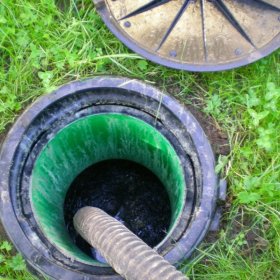
Typically, cleaning cesspools is an unpleasant activity. Some summer residents cope with this task on their own, while others hire specialists-scavengers. Modern facilities expand the capabilities of owners of this type of treatment facilities, making their operation and treatment less unpleasant and safer. To solve the question of how to clean a cesspool, it is necessary to find out its type, since this simple device can be very different. After that, you can already select the appropriate cleaning method.
First of all, it is necessary to find out a number of such important factors as:
- Does the cesspool have a bottom or is it an unpressurized structure?
- What is the total volume of the pit?
- Are there access roads for the car of the dump trucks?
- What type of drains are in the pit?
These and other questions will help you choose a strategy for further action. You can try to clean a small container yourself. But you need to be extremely careful. So, after cleaning the cesspool without a bottom, restoration of the drainage system may be required. And if you decide to use biological cleaning agents, you should take into account the chemical composition of the effluent, etc.
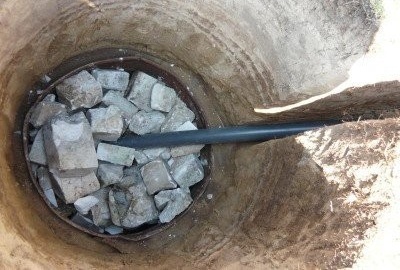
After mechanical cleaning of a cesspool without a bottom, sometimes it may be necessary to restore its drainage properties. To remove hard deposits, biological products can be used for the final decomposition of effluents.
Note. Sometimes cleaning of cesspools is not necessary, for example, if we are talking about a small tank located under the country toilet. Such a hole can simply be buried, after adding there a means to accelerate the compost formation. After some time, near the pit with compost, you can plant a fruit tree, which will perfectly bear fruit. And the toilet is transferred to a new place with a new cesspool.
Most often, for cleaning containers with wastewater is used:
- mechanical methods;
- chemical methods;
- biological methods.
When choosing a suitable method, one should take into account its availability, cost and environmental safety.
Method # 1 - Mechanical Cleaning
The simplest but not the most pleasant way to clean septic tanks and cesspools is mechanical. To do this, use a special machine called a suction pump. Visually, the work of a modern ilosos is presented in the following video material:
Modern technology allows you to get rid of sewage, almost without feeling discomfort from the smell characteristic of feces. Previously, this moment could spoil the mood not only to the owners of a private house, but also to their immediate neighbors.
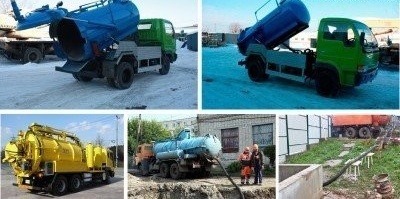
Modern sludge pumps can be used for mechanical cleaning of a cesspool with high efficiency. Waste water will be removed quickly and accurately.
If you decide to choose this method of cleaning, then you should take care of two main points:
- provide access roads for equipment;
- consider the length of the suction hose, which is usually about three meters.
If the depth of the cesspool exceeds this figure, you will have to look for additional opportunities for cleaning it.
Note! If the volume of the cesspool is made a multiple of the volume of the scavenger machine, you can save a little, because the payment is made for the service, and not for the specific amount of drained waste.
Some owners of small cottages have figured out how to clean a cesspool without involving hired equipment. To do this, you can use a special fecal pump. Automatic models of such pumps are used constantly, they turn on and off when the amount of effluent reaches a certain level.
Sometimes cleaning is carried out using a conventional water pump in combination with a special filter. However, it should be remembered that a technique not intended for such procedures will break down rather quickly.
It's important to know! With a long service life, dense sediment accumulates on the walls of the treatment plant, which must be removed using special chemicals or biological products.
Method # 2 - Chemicals
Chemicals have been used as cleaning agents for cesspools for quite some time. Among the popular drugs of this type can be noted:
- formaldehyde;
- bleach;
- ammonium compounds;
- nitrogen fertilizers.
It should immediately be recalled that all of these substances are quite aggressive. On the one hand, they cope with any waste and household chemicals. On the other hand, you should not use them in systems with metal pipes, since they also successfully corrode metal.
The most inexpensive chemicals are formaldehyde and bleach. These substances, especially formaldehyde, are extremely dangerous for human health, therefore, at present, they are practically not used to remove effluents.
Ammonium compounds are much safer, but they are sensitive to household chemicals, the presence of which in wastewater can cause a decrease in the manufacturer's declared efficiency. Using ammonium compounds, you can quickly get rid of the unpleasant odor and accelerate the decomposition of effluents.
Nitrogen fertilizers, which are also called nitrate oxidizing agents, are quite expensive, but are considered the safest among the chemicals that are used to treat wastewater. It should be remembered that their impact on the environment is not well studied.
Environmentalists are not enthusiastic about the use of such dangerous and aggressive chemicals in the household. They are being replaced by substances of a new generation - biological preparations.
Method # 3 - bacteria work
Biological products that are used to clean septic tanks and cesspools are becoming more widespread. They are a collection of aerobic or anaerobic bacteria that provide wastewater treatment. The processes occurring in this case are completely safe, both for human health and for the environment, since similar reactions occur in the soil where these microorganisms live.
More suitable for cesspools are considered to be sets of anaerobic bacteria that do not need oxygen in order to carry out their work. Aerobic bacteria are more often used in septic tanks or two-chamber cesspools. With their help, post-treatment of effluents already treated with anaerobic microorganisms is carried out.
In that part of treatment facilities where aerobic preparations are used, it is necessary to specifically blow air. Such a two-stage treatment allows the use of water for technical needs, for example, for watering plants. If the drains were cleaned only with anaerobic drugs, they should be allowed to enter the soil slowly through the drainage system. Bacteria in the soil will be final cleaned.From the sealed cesspool, the treated water is pumped out with a conventional water pump.
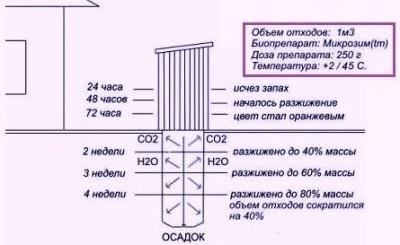
As a result of the work of bacteria, sewage decomposes into water, disinfected sludge and carbon dioxide. The resulting sediment can be used as fertilizer
The procedure for using biological products is very simple. Usually the powder or liquid is diluted in some water and poured through the hatch of the cesspool. Sometimes you can just pour the drug into the toilet and wash it off several times.
Most bacteria are very sensitive to aggressive household chemicals, such as chlorine products. Recently, however, more stable sets of bacteria have appeared on the market that are more expensive than conventional drugs. You must either abandon the use of aggressive chemicals, or plan additional costs for the most effective biological products.
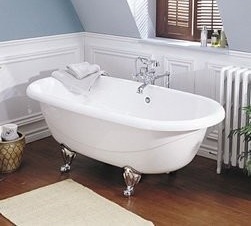


3 comments